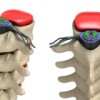The sciatic nerve (arrow) consists of several nerve branches that originate at the spine (circles). “Sciatica” can be caused by irritation at one or more of these areas.
The piriformis muscle (center of picture) is a common site of sciatic nerve impingement.
The symptoms of sciatica often include sharp pain, numbness, tingling or burning in the back of the legs. In severe circumstances, weakness in the legs can also be seen.
The sciatic nerve is a large nerve that travels down the back of the leg to the bottom of the foot. It includes several smaller nerves and originates from the spine at the level of the low back. It passes under the piriformis muscles, which lies under the gluteus maximus muscle (main buttock muscle) on its way down the leg. Irritation of the sciatic nerve at any point along its path is commonly referred to as “sciatica”.
A diagnosis of sciatica, however, is often of little use to the sufferer unless it specifically indicates where along the nerve the irritation is occurring. Although entrapment of the nerve can happen in several different places, the two most common sites are where the nerve originates at the spine and where the nerve passes under the piriformis muscle.
Both cases respond well to chiropractic, although treatment can be drastically different depending on the cause.
Sciatica Related to Nerve Irritation at the Spine
Irritation of the nerve as it exits the spine is often the result of mechanical dysfunction of the joints of the spine. Occasionally, the nerves exiting the spine can become “pinched”. Although the traditional idea of an impinged nerve is one that is sandwiched between two bones, we now know that nerves can become irritated at the spine in a number of different ways. Nerves can be pressed upon by bulging discs, encroached on by bony overgrowth or “stuck” to surrounding soft tissues (muscles, ligaments, fascia).
Treatment of Sciatica Related to Joint Dysfunction or Bone Malposition
Sciatica related to joint dysfunction or bone malposition is best corrected using chiropractic adjustments. By using carefully directed and controlled pressure to restore joints to a normal position and motion, the pressure placed on the nerve is quickly and painlessly reduced. This often results in immediate (sometimes dramatic) pain relief.
Sciatica related to disc injury often requires additional treatment methods. The McKenzie protocol and Cox Flexion/Traction are both techniques available in our office. The aim of the McKenzie protocol is to reduce nerve impingement by “reshaping” the spinal disc with sustained pressure over successive treatments. Cox Flexion/Traction uses a specialized chiropractic table that bends and elongates the spine to reduce pressure within the disc. Both techniques are capable of providing both immediate pain relief and rehabilitation to prevent future recurrences.
Treatment of Sciatica Caused by Bulging Discs
Non-Surgical Spinal Disc Decompression provides relief to sciatica sufferers by gently reducing the pressure within spinal discs.
The most effective treatment available to reverse sciatica caused by a disc bulge or herniated disc is Non-Surgical Spinal Disc Decompression using the DTS Spinal Decompression Machine.
DTS Spinal Decompression is a non-surgical, state-of-the-art treatment which provides relief to severe back and neck pain. The bones of the spine are slowly and gently separated. As the vertebrae are separated, pressure within the disc (intradiscal pressure) is reduced to the point where a vacuum is formed. This vacuum “sucks” the gelatinous center of the disc back into the disc thereby reducing the Disc Bulge. This takes pressure off the spinal nerves and drastically reduces pain. This action also allows much-needed oxygen and nutrients to flow into the injured discs to aid in the healing process.
 |
 |
Sciatica Related to Entrapment at the Piriformis Muscle
The sciatic nerve passes directly under or through the piriformis muscle (in most people). When healthy, the nerve should slide easily within its sheath and never “stick” to the muscle directly. This is important as the nerve stretches like a rubber band with certain movements of the spine and legs.
Traumatic injuries or repetitive motions can cause inflammation to reside near the piriformis muscle. This inflammatory process can lead to the formation of scar tissue “adhesions” that can force the piriformis muscle and nerve to become “stuck” to one another. The first symptom is usually stiffness in the low back, hips or legs. If allowed to progress, stiffness can degrade to typical “sciatica” symptoms: sharp pain, numbness, tingling and weakness in the buttocks or back of the legs.
Treatment of Sciatica Related to Entrapment at the Piriformis Muscle
The goal of treatment is to loosen the adhesion between the muscle and nerve and allow the piriformis muscle to regain its complete length and strength. Elongation of the piriformis muscle and separation of the adhesion between the nerve and muscle is best accomplished with the Active Release Technique, but the source of the initial problem must also be addressed. This is usually accomplished by applying specific pressure with a thumb or finger at the piriformis muscle while moving the hip or leg through a full and complete range of motion. Using this technique, the adhered tissue is held stationary while the nerve is pulled away and separated from the adhesion. This often creates an immediate reduction in nerve tension and, therefore, immediate (sometimes dramatic) symptom relief.
The piriformis muscle can become chronically tight due to an uncorrected sacroiliac joint problem, hip joint dysfunction or anterior pelvic misalignment (pubic symphysis). Common causes include running and cycling sports, prolonged sitting, auto accident with a foot on the brake at the time of the accident or pregnancy/childbirth.
Chiropractic adjustments commonly correct these dysfunctions allowing the supporting musculature to return to a healthy, balanced state. The primary goal of chiropractic is to locate and correct the cause of your problem. Treatment of the muscle alone will likely provide only temporary benefit as the dysfunctional joint will merely cause the muscles to become unbalanced again over time. Likewise, ignoring the muscles and only treating the joints will often produce mediocre results as the muscles pull the joints back into dysfunction. A combined approach of corrective chiropractic adjustments and restorative Active Release muscle work is often the most effective approach.




